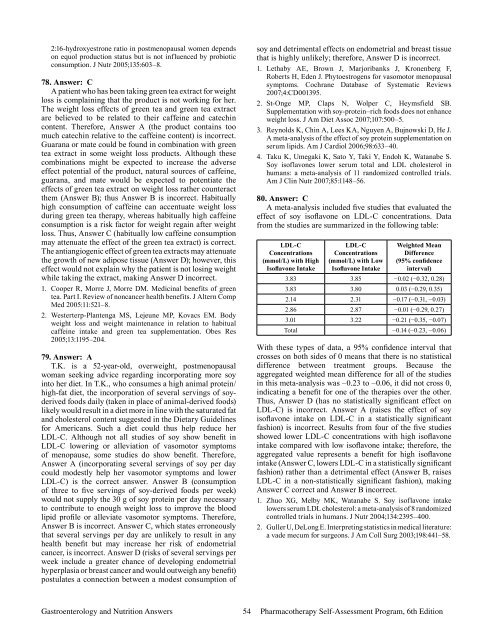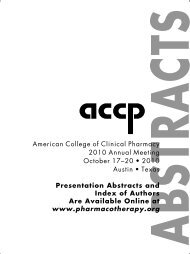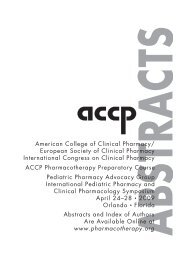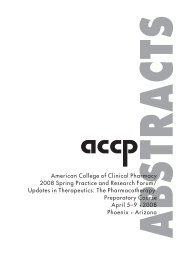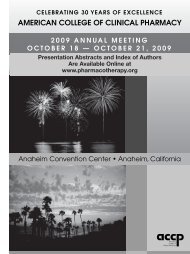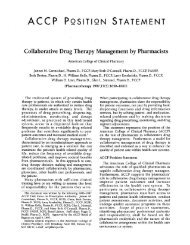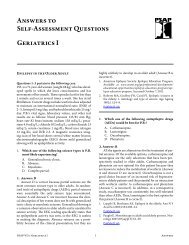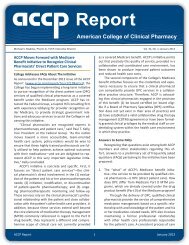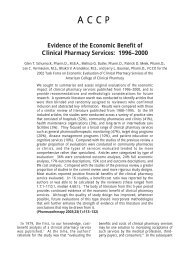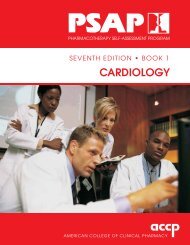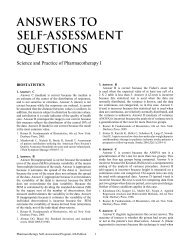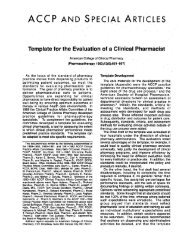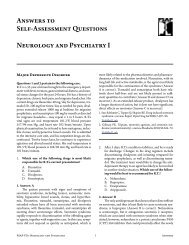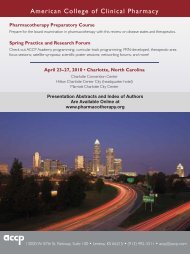Answers to Self-Assessment Questions - ACCP
Answers to Self-Assessment Questions - ACCP
Answers to Self-Assessment Questions - ACCP
Create successful ePaper yourself
Turn your PDF publications into a flip-book with our unique Google optimized e-Paper software.
2:16-hydroxyestrone ratio in postmenopausal women depends<br />
on equol production status but is not influenced by probiotic<br />
consumption. J Nutr 2005;135:603–8.<br />
78. Answer: C<br />
A patient who has been taking green tea extract for weight<br />
loss is complaining that the product is not working for her.<br />
The weight loss effects of green tea and green tea extract<br />
are believed <strong>to</strong> be related <strong>to</strong> their caffeine and catechin<br />
content. Therefore, Answer A (the product contains <strong>to</strong>o<br />
much catechin relative <strong>to</strong> the caffeine content) is incorrect.<br />
Guarana or mate could be found in combination with green<br />
tea extract in some weight loss products. Although these<br />
combinations might be expected <strong>to</strong> increase the adverse<br />
effect potential of the product, natural sources of caffeine,<br />
guarana, and mate would be expected <strong>to</strong> potentiate the<br />
effects of green tea extract on weight loss rather counteract<br />
them (Answer B); thus Answer B is incorrect. Habitually<br />
high consumption of caffeine can accentuate weight loss<br />
during green tea therapy, whereas habitually high caffeine<br />
consumption is a risk fac<strong>to</strong>r for weight regain after weight<br />
loss. Thus, Answer C (habitually low caffeine consumption<br />
may attenuate the effect of the green tea extract) is correct.<br />
The antiangiogenic effect of green tea extracts may attenuate<br />
the growth of new adipose tissue (Answer D); however, this<br />
effect would not explain why the patient is not losing weight<br />
while taking the extract, making Answer D incorrect.<br />
1. Cooper R, Morre J, Morre DM. Medicinal benefits of green<br />
tea. Part I. Review of noncancer health benefits. J Altern Comp<br />
Med 2005:11:521–8.<br />
2. Westerterp-Plantenga MS, Lejeune MP, Kovacs EM. Body<br />
weight loss and weight maintenance in relation <strong>to</strong> habitual<br />
caffeine intake and green tea supplementation. Obes Res<br />
2005;13:1195–204.<br />
79. Answer: A<br />
T.K. is a 52-year-old, overweight, postmenopausal<br />
woman seeking advice regarding incorporating more soy<br />
in<strong>to</strong> her diet. In T.K., who consumes a high animal protein/<br />
high-fat diet, the incorporation of several servings of soyderived<br />
foods daily (taken in place of animal-derived foods)<br />
likely would result in a diet more in line with the saturated fat<br />
and cholesterol content suggested in the Dietary Guidelines<br />
for Americans. Such a diet could thus help reduce her<br />
LDL-C. Although not all studies of soy show benefit in<br />
LDL-C lowering or alleviation of vasomo<strong>to</strong>r symp<strong>to</strong>ms<br />
of menopause, some studies do show benefit. Therefore,<br />
Answer A (incorporating several servings of soy per day<br />
could modestly help her vasomo<strong>to</strong>r symp<strong>to</strong>ms and lower<br />
LDL-C) is the correct answer. Answer B (consumption<br />
of three <strong>to</strong> five servings of soy-derived foods per week)<br />
would not supply the 30 g of soy protein per day necessary<br />
<strong>to</strong> contribute <strong>to</strong> enough weight loss <strong>to</strong> improve the blood<br />
lipid profile or alleviate vasomo<strong>to</strong>r symp<strong>to</strong>ms. Therefore,<br />
Answer B is incorrect. Answer C, which states erroneously<br />
that several servings per day are unlikely <strong>to</strong> result in any<br />
health benefit but may increase her risk of endometrial<br />
cancer, is incorrect. Answer D (risks of several servings per<br />
week include a greater chance of developing endometrial<br />
hyperplasia or breast cancer and would outweigh any benefit)<br />
postulates a connection between a modest consumption of<br />
soy and detrimental effects on endometrial and breast tissue<br />
that is highly unlikely; therefore, Answer D is incorrect.<br />
1. Lethaby AE, Brown J, Marjoribanks J, Kronenberg F,<br />
Roberts H, Eden J. Phy<strong>to</strong>estrogens for vasomo<strong>to</strong>r menopausal<br />
symp<strong>to</strong>ms. Cochrane Database of Systematic Reviews<br />
2007;4:CD001395.<br />
2. St-Onge MP, Claps N, Wolper C, Heymsfield SB.<br />
Supplementation with soy-protein–rich foods does not enhance<br />
weight loss. J Am Diet Assoc 2007;107:500–5.<br />
3. Reynolds K, Chin A, Lees KA, Nguyen A, Bujnowski D, He J.<br />
A meta-analysis of the effect of soy protein supplementation on<br />
serum lipids. Am J Cardiol 2006;98:633–40.<br />
4. Taku K, Umegaki K, Sa<strong>to</strong> Y, Taki Y, Endoh K, Watanabe S.<br />
Soy isoflavones lower serum <strong>to</strong>tal and LDL cholesterol in<br />
humans: a meta-analysis of 11 randomized controlled trials.<br />
Am J Clin Nutr 2007;85:1148–56.<br />
80. Answer: C<br />
A meta-analysis included five studies that evaluated the<br />
effect of soy isoflavone on LDL-C concentrations. Data<br />
from the studies are summarized in the following table:<br />
LDL-C<br />
Concentrations<br />
(mmol/L) with High<br />
Isoflavone Intake<br />
LDL-C<br />
Concentrations<br />
(mmol/L) with Low<br />
Isoflavone Intake<br />
Weighted Mean<br />
Difference<br />
(95% confidence<br />
interval)<br />
3.83 3.85 −0.02 (−0.32, 0.28)<br />
3.83 3.80 0.03 (−0.29, 0.35)<br />
2.14 2.31 −0.17 (−0.31, −0.03)<br />
2.86 2.87 −0.01 (−0.29, 0.27)<br />
3.01 3.22 −0.21 (−0.35, −0.07)<br />
Total<br />
−0.14 (−0.23, −0.06)<br />
With these types of data, a 95% confidence interval that<br />
crosses on both sides of 0 means that there is no statistical<br />
difference between treatment groups. Because the<br />
aggregated weighted mean difference for all of the studies<br />
in this meta-analysis was –0.23 <strong>to</strong> –0.06, it did not cross 0,<br />
indicating a benefit for one of the therapies over the other.<br />
Thus, Answer D (has no statistically significant effect on<br />
LDL-C) is incorrect. Answer A (raises the effect of soy<br />
isoflavone intake on LDL-C in a statistically significant<br />
fashion) is incorrect. Results from four of the five studies<br />
showed lower LDL-C concentrations with high isoflavone<br />
intake compared with low isoflavone intake; therefore, the<br />
aggregated value represents a benefit for high isoflavone<br />
intake (Answer C, lowers LDL-C in a statistically significant<br />
fashion) rather than a detrimental effect (Answer B, raises<br />
LDL-C in a non-statistically significant fashion), making<br />
Answer C correct and Answer B incorrect.<br />
1. Zhuo XG, Melby MK, Watanabe S. Soy isoflavone intake<br />
lowers serum LDL cholesterol: a meta-analysis of 8 randomized<br />
controlled trials in humans. J Nutr 2004;134:2395–400.<br />
2. Guller U, DeLong E. Interpreting statistics in medical literature:<br />
a vade mecum for surgeons. J Am Coll Surg 2003;198:441–58.<br />
Gastroenterology and Nutrition <strong>Answers</strong><br />
54<br />
Pharmacotherapy <strong>Self</strong>-<strong>Assessment</strong> Program, 6th Edition


